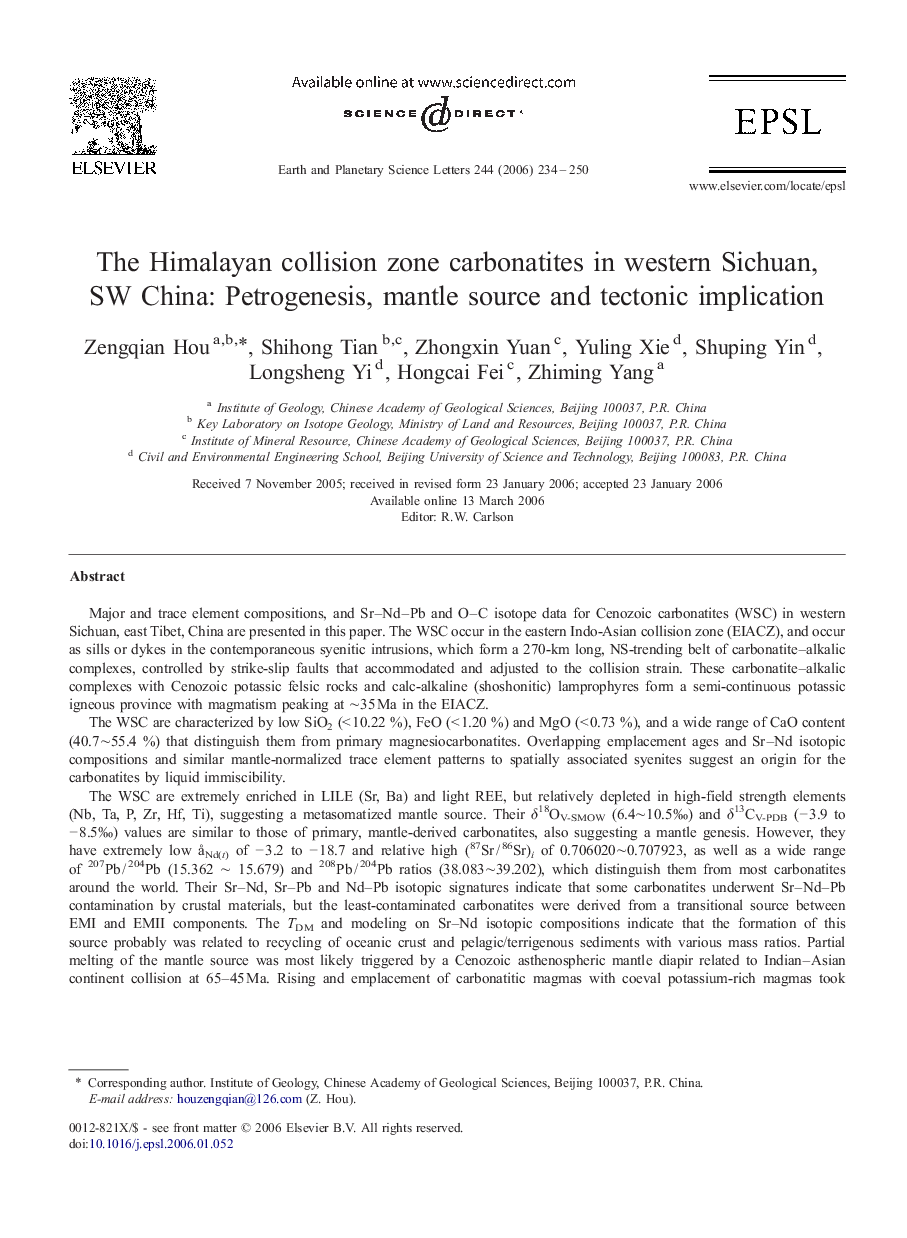| کد مقاله | کد نشریه | سال انتشار | مقاله انگلیسی | نسخه تمام متن |
|---|---|---|---|---|
| 4681066 | 1634947 | 2006 | 17 صفحه PDF | دانلود رایگان |

Major and trace element compositions, and Sr–Nd–Pb and O–C isotope data for Cenozoic carbonatites (WSC) in western Sichuan, east Tibet, China are presented in this paper. The WSC occur in the eastern Indo-Asian collision zone (EIACZ), and occur as sills or dykes in the contemporaneous syenitic intrusions, which form a 270-km long, NS-trending belt of carbonatite–alkalic complexes, controlled by strike-slip faults that accommodated and adjusted to the collision strain. These carbonatite–alkalic complexes with Cenozoic potassic felsic rocks and calc-alkaline (shoshonitic) lamprophyres form a semi-continuous potassic igneous province with magmatism peaking at ∼35 Ma in the EIACZ.The WSC are characterized by low SiO2 (< 10.22 %), FeO (< 1.20 %) and MgO (< 0.73 %), and a wide range of CaO content (40.7∼55.4 %) that distinguish them from primary magnesiocarbonatites. Overlapping emplacement ages and Sr–Nd isotopic compositions and similar mantle-normalized trace element patterns to spatially associated syenites suggest an origin for the carbonatites by liquid immiscibility.The WSC are extremely enriched in LILE (Sr, Ba) and light REE, but relatively depleted in high-field strength elements (Nb, Ta, P, Zr, Hf, Ti), suggesting a metasomatized mantle source. Their δ18OV-SMOW (6.4∼10.5‰) and δ13CV-PDB (− 3.9 to − 8.5‰) values are similar to those of primary, mantle-derived carbonatites, also suggesting a mantle genesis. However, they have extremely low åNd(t) of − 3.2 to − 18.7 and relative high (87Sr / 86Sr)i of 0.706020∼0.707923, as well as a wide range of 207Pb / 204Pb (15.362 ∼ 15.679) and 208Pb / 204Pb ratios (38.083∼39.202), which distinguish them from most carbonatites around the world. Their Sr–Nd, Sr–Pb and Nd–Pb isotopic signatures indicate that some carbonatites underwent Sr–Nd–Pb contamination by crustal materials, but the least-contaminated carbonatites were derived from a transitional source between EMI and EMII components. The TDM and modeling on Sr–Nd isotopic compositions indicate that the formation of this source probably was related to recycling of oceanic crust and pelagic/terrigenous sediments with various mass ratios. Partial melting of the mantle source was most likely triggered by a Cenozoic asthenospheric mantle diapir related to Indian–Asian continent collision at 65–45 Ma. Rising and emplacement of carbonatitic magmas with coeval potassium-rich magmas took place in the tectonic regime of the transition from transpression to transtension at Eocene/Oligocene boundary in the EIACZ.
Journal: Earth and Planetary Science Letters - Volume 244, Issues 1–2, 15 April 2006, Pages 234–250